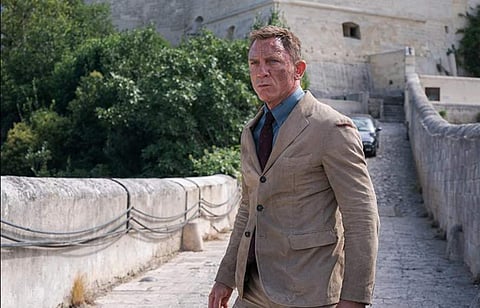

The 25th film from the James Bond series, No Time to Die holds the distinction, for being the first in quite a few aspects. The film's director, Cary Joji Fukunaga, is the first American to direct a Bond film and is also the first to get writing credits. It also marks the first time a female screenwriter (Fleabag-fame Phoebe Waller-Bridge) is credited in a Bond film after almost 60 years. Léa Seydoux returns to play the role of Madeleine Swann, making her the first female lead to appear in successive Bond films while Jeffrey Wright, who plays the recurring character and Bond's friend Felix Leiter, becomes the first actor to play that character three times. As for technology, the film is the first to have sequences shot with 65mm IMAX film cameras. And needless to say, this Bond film, No Time to Die, was the first major Hollywood film to be affected by the pandemic. And yet, despite all these firsts, it’s one ‘last’ that the fans of this franchise will remember this film for: This is the last outing of Daniel Craig as the famous M16 agent, 007.
Director: Cary Joji Fukunaga
Cast: Daniel Craig, Léa Seydoux, Rami Malek, Lashana Lynch
When ghosts of his past come back to haunt him, Bond has to forgo his one true love and a lot more, to save the world from a bioweapon named Project Heracles. In a world in which everyone seems to have shades of grey, No Time to Die brings to the party a new villain in the form of Lyutsifer Safin (Rami Malek). It also brings back the franchise's long-time regular, both in the novels and the films, Ernst Stavro Blofeld (Christoph Waltz). And yet, more than these adversaries, it's the race against time in both his professional and personal life that poses the biggest challenge for Bond. Director Cary Joji Fukunaga, in his first major outing, makes Bond look the oldest he has ever been, and it adds a sense of vulnerability to a character that's usually so invincible that he can bring an army down while wearing his tuxedo and holding a martini… shaken and not stirred, of course.
As one of the longest-running film series, James Bond films have had their share of politically incorrect content that even a license to kill wouldn't save them in today’s times. From dressing up as a Japanese person, indulging in casual racism, manhandling women, and even refusing to take no for an answer, Bond's previous iterations have had an infamous tryst with the dark side. As Judi Dench's M said in GoldenEye, "I think you're a sexist, misogynist dinosaur. A relic of the Cold War." Thankfully, along with that version of M, these characteristics of Bond have retired too, and after days of high-flying action, innumerable Bond girls and one-dimensional villains who were put to the sword by the likes of Sean Connery, Roger Moore, and Pierce Brosnan, we have had a 'functional' Bond in Daniel Craig. It’s that air of duty, along with a healthy dose of vulnerability that’s unusual for this franchise, that makes No Time to Die one of the best Bond films and a perfect send-off for Craig.
The craft is great too. Hans Zimmer's score elevates this film, as does cinematography by Linus Sandgren (La La Land) which does a great job of covering a wide range of terrain and bringing in dynamism to the action sequences. Fans of the franchise might also notice how people indulge more in a war of words rather than of the traditional variety. The action that has made this series a genre-defining one, isn’t as much on display here, and I mean this as a compliment, as it all feels organic. When we do get the action bits though, they are a treat. Fukunaga also laces the film with references and callbacks to previous Bond films. Persian Cats are synonymous with the black and white iterations of Ernst Stavro Blofeld, and has become a villain den staple, right from Team Rocket leader Giovanni in Pokemon to the Austin Powers film series. The cat gets referenced as Q's pet. Craig utters the insanely famous 'Bond, James Bond' line in the oddest of scenes in an innately comical manner.
The runtime is a tad too long, and perhaps a strong villain was needed too. However, Fukunaga makes up for it, along with screenwriters Neal Purvis, Robert Wade and Waller-Bridge, by coming up with well-written female characters. Madeleine Swann (Léa Seydoux) goes all The Spy Who Loved Me over Bond who is battling unresolved trauma stemming from the death of Vesper Lynd in Casino Royale. On the other hand, we also have Captain Marvel-fame Lashana Lynch playing Nomi, a new 00 agent. The man himself, Craig, proves once again why his take on the British Agent will be an important one in the evolution of a character that's more than 60 years old. No Time to Die's Bond is no longer the epitome of extraordinary human ability: he pants when he runs, he bleeds (more often than we have seen in a JB film), often limps, and why, has bullets even meeting his wrinkled skin. While a character like James Bond can never be relatable to a common man, Fukunaga makes this hero an impulsive and delicate individual, and an expendable cog in Her Majesty's secret service, with the pendulum of time hanging over him like a guillotine.
Unlike in previous iterations in which 007 was on the driver's seat of the film’s events, No Time to Die's Bond is often reactive, and it’s a version we haven't seen for a long time. This allows the latest iteration to be a mishmash of genres that works in favour of the film. No Time to Die is a fitting finale to Daniel Craig's James Bond and the makers have tastefully adapted this old spy for the modern world. Where does this franchise go from here? Well, Tomorrow Never Dies.